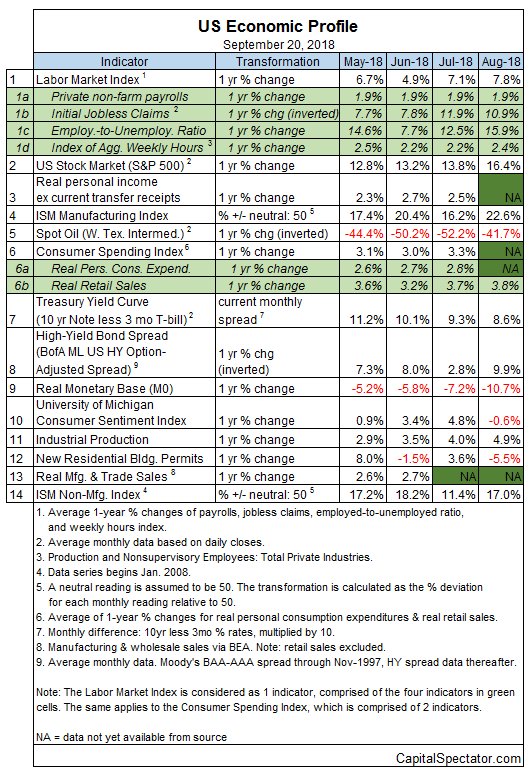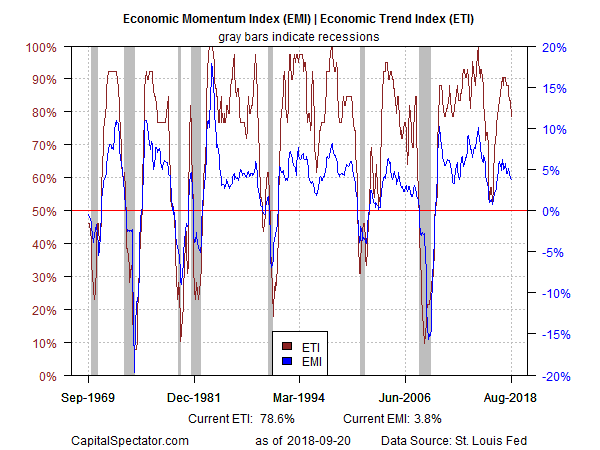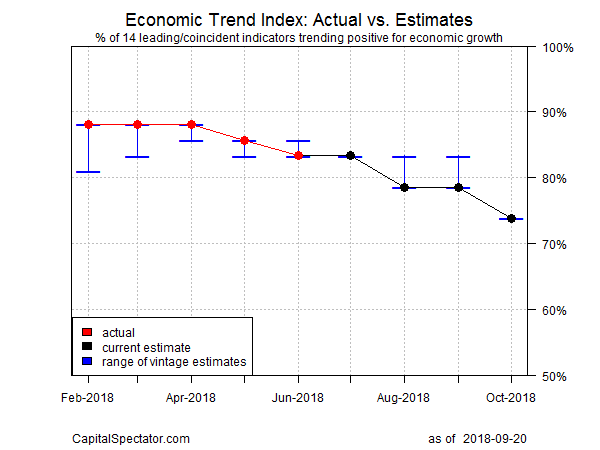
- All Instrument Types
- Indices
- Equities
- ETFs
- Funds
- Commodities
- Currencies
- Crypto
- Bonds
- Certificates
Please try another search

US Business Cycle Risk Report | 20 August 2018

US economic growth remains strong, based on data published to date, but today’s business-cycle profile continues to suggest that we’ve seen the peak. Recession risk remains low and near-term projections point to more of the same. The question is whether there’s trouble brewing for 2019?
At this stage it’s too early to answer with anything more than rank speculation. Looking beyond two or three months for business-cycle analysis is always a guessing game. As such, the upbeat state of the economy in the here and now remains the best guess until yet-to-be-published numbers offer a convincing reason to think otherwise. Nonetheless, the rear-view mirror tells us that the cycle has peaked and so the only mystery at this point: How far, how deep, and how long will the deceleration run?
Leaving those crucial questions aside, the macro profile for the US remains healthy. Consider, for instance, that the average nowcast for GDP growth in the third quarter (based on current estimates via the Atlanta Fed and New York Fed’) is a solid 3.3%. That’s a moderate decline from Q2’s sizzling 4.2% increase, but the current outlook for Q3 betrays no sign that a recession is imminent.
No surprise, then, that The Capital Spectator continues to estimate a virtually nil probability that a new NBER-defined downturn started in August, based on a diversified set of economic indicators. (For a more comprehensive review of the macro trend with weekly updates, see The US Business Cycle Risk Report.) One implication: Monday’s release (Sep. 24) of the Chicago Fed’s National Activity Index for August (based on the three-month average) will likely confirm that recession risk was low last month.

Aggregating the data in the table above continues to indicate a strong positive trend overall. The Economic Trend and Momentum indices (ETI and EMI, respectively) remain well above their respective danger zones (50% for ETI and 0% for EMI). When/if the indexes fall below those tipping points, the declines will mark warning signs that recession risk is elevated and a new downturn has started or is near. The analysis is based on a methodology that’s profiled in my book on monitoring the business cycle.
Note, however, that ETI and EMI, while still firmly in positive terrain, continue to reflect decelerating trends, as shown in the chart below. To be fair, the current round of softer growth readings may be a temporary slide that occurs from time to time in a period of ongoing expansion. Alternatively, the softer readings could also be the start of an extended decline that eventually leads to a new recession warning. Projecting the data out on this basis, which is highly speculative at this point, sees a recession starting as early as March 2019. For now, that’s a scenario that deserves monitoring as new data is released. It’s also a potential warning that should viewed with extreme skepticism until or if incoming numbers send a different message.

Meantime, let’s turn to the current economic profile, based on figures published so far. Translating ETI’s historical values into recession-risk probabilities via a probit model points to low business-cycle risk for the US through last month. Analyzing the data in this framework indicates that the odds remain effectively zero that NBER will declare August as the start of a new recession.

For the near-term outlook, consider how ETI may evolve as new data is published. One way to project values for this index is with an econometric technique known as an autoregressive integrated moving average (ARIMA) model, based on calculations via the “forecast” package in R. The ARIMA model calculates the missing data points for each indicator for each month — in this case through September 2018. (Note that June 2018 is currently the latest month with a complete set of published data for ETI.) Based on today’s projections, ETI is expected to remain well above its danger zone through next month.

Forecasts are always suspect, but recent projections of ETI for the near-term future have proven to be reliable guesstimates vs. the full set of published numbers that followed. That’s not surprising, given ETI’s design to capture the broad trend based on multiple indicators. Predicting individual components, by contrast, is subject to greater uncertainty. The assumption here is that while any one forecast for a given indicator will likely be wrong, the errors may cancel out to some degree by aggregating a broad set of predictions. That’s a reasonable view, based on the generally accurate historical record for the ETI forecasts in recent years.
The current projections (the four black dots in the chart above) suggest that the economy will continue to expand. The chart also shows the range of vintage ETI projections published on these pages in previous months (blue bars), which you can compare with the actual data (red dots) that followed, based on current numbers.
Related Articles

If there was a "Stock of the Year" award, it would certainly go to Nvidia (NASDAQ:NVDA). As a result of the continued AI boom, the market cap of this semiconductor manufacturer...

A data provider tracks the stocks trades of members of Congress An asset management firm created two ETFs tracking how Congress members invest The Democratic and...

Below we can see how the top stocks in the S&P 500, as tracked by the Invesco S&P 500® Top 50 ETF (NYSE:XLG), have gained 22.5% in 2024. That easily beats the SPDR®...
Are you sure you want to block %USER_NAME%?
By doing so, you and %USER_NAME% will not be able to see any of each other's Investing.com's posts.
%USER_NAME% was successfully added to your Block List
Since you’ve just unblocked this person, you must wait 48 hours before renewing the block.
I feel that this comment is:
Thank You!
Your report has been sent to our moderators for review





Add a Comment
We encourage you to use comments to engage with other users, share your perspective and ask questions of authors and each other. However, in order to maintain the high level of discourse we’ve all come to value and expect, please keep the following criteria in mind:
Enrich the conversation, don’t trash it.
Stay focused and on track. Only post material that’s relevant to the topic being discussed.
Be respectful. Even negative opinions can be framed positively and diplomatically. Avoid profanity, slander or personal attacks directed at an author or another user. Racism, sexism and other forms of discrimination will not be tolerated.
Perpetrators of spam or abuse will be deleted from the site and prohibited from future registration at Investing.com’s discretion.